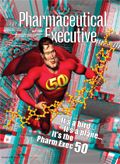Another Dimension
Pharmaceutical Executive
Our 3-D cover jumps off the page. But the real question for us (and for you) is how do we get everything else to connect?
When our publisher, Jay Berfas, first came to Pharm Exec, he brought with him a fat black portfolio. We all learned what was inside when Jay gathered the editorial team around a table and poured out three decades' worth of 3-D memorabilia—magazine covers, ads, photos, and dozens of pairs of red-and-blue glasses. It turned out that Jay was (and is) a 3-D fanatic, and had been trying for years to do a stereoscopic cover on one of his magazines. Now we were part of the dream.

Not long afterward, we were able to introduce Jay to a fellow 3-D nut, Craig Foster. We met Craig at a photo shoot for our annual Ad Stars feature. Craig was responsible for the artwork for one of our winners—a gorgeous, three-dimensional mailer for Avastin. Business cards were exchanged and e-mails started flying, and next thing we knew we'd entered a new dimension. We have to thank Craig for a lot of that speed, and for the remarkable quality of his work. You can check out a selection of his medical illustrations at fostermed.com. (That's Craig, by the way, fourth from the left in the front row of the photo above. The rest of the folks in goofy glasses are the Pharm Exec team: Joanna Breitstein, Marylyn Donahue, Tony Gamino, Brittany Agro, me, Jay, Matthew Kalash, Walter Armstrong, Daisy Roman-Torres, George Koroneos, and Laurel Petty.)
For all the fun we had getting "50 Man" on the page, there's a serious issue lurking behind the idea. The whole point of 3-D is to get things to jump off the page. And that's a challenge we all face these days. In today's media-saturated world, it has never been easier to get information in front of an audience. But it has never been harder to get a message to actually have an impact on behavior.
Part of the problem, I suppose, is simple competition. There's just so much information out there that we can't pay attention to everything. But I feel that a lot of us are developing a resistance to taking in new information—even new information we know we need.
Neurologists have to contend with the blood-brain barrier, which is the brain's mechanism for allowing in familiar substances like oxygen, while keeping out potentially dangerous chemicals and organisms. In neurology, the problem is that the barrier sometimes keeps needed therapies from reaching their target. I think those of us who deliver words have a similar problem. Important information on safety, disease states, compliance, and, yes, the reasons patients should use a new drug often don't make it through.
Which means the challenge has changed. No longer do we worry only about getting the message onto the page or screen. We need to worry about getting it into the patient. When you recall this month's 50 Man, as we hope you will, remember this: He can't save the world if he just sits on the page. He's got to fly.
On a sadder note, with this issue, we bid farewell to Executive Editor Joanna Breitstein, who for the past nine years has been the heart and soul of Pharm Exec. She leaves us to pursue her true passion, public health, at the TB Alliance. She takes with her our deep gratitude and our deeper affection, and we are pleased to announce that she will continue to be a part of the family, as the newest member of our editorial advisory board.
Patrick Clinton
Editor-in-chief
Addressing Disparities in Psoriasis Trials: Takeda's Strategies for Inclusivity in Clinical Research
April 14th 2025LaShell Robinson, Head of Global Feasibility and Trial Equity at Takeda, speaks about the company's strategies to engage patients in underrepresented populations in its phase III psoriasis trials.
Merck’s Oral TLR7/8 Inhibitor Reduces Disease Activity in Cutaneous, Systemic Lupus
May 21st 2025Results from the Phase II WILLOW trial show that enpatoran achieved a statistically significant dose-response and clinically meaningful reduction in disease activity in cutaneous and systemic lupus erythematosus with active rash.
Beyond the Prescription: Pharma's Role in Digital Health Conversations
April 1st 2025Join us for an insightful conversation with Jennifer Harakal, Head of Regulatory Affairs at Canopy Life Sciences, as we unpack the evolving intersection of social media and healthcare decisions. Discover how pharmaceutical companies can navigate regulatory challenges while meaningfully engaging with consumers in digital spaces. Jennifer shares expert strategies for responsible marketing, working with influencers, and creating educational content that bridges the gap between patients and healthcare providers. A must-listen for pharma marketers looking to build trust and compliance in today's social media landscape.
